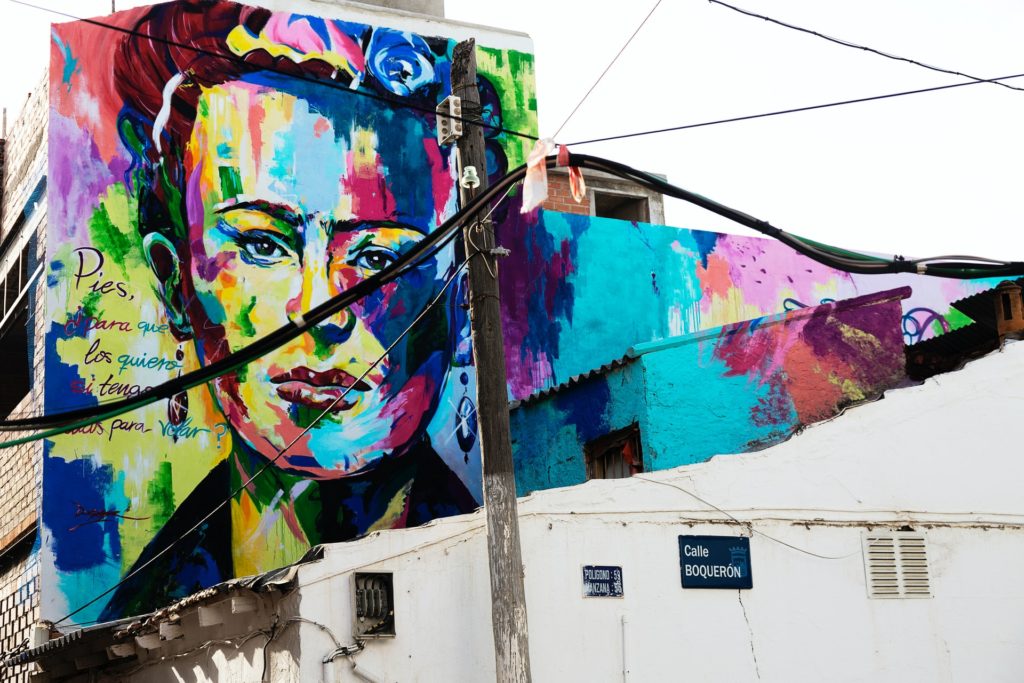Frida Kahlo’s Final Years and Legacy Posted by sasha on Apr 6, 2022 in Spanish Culture
In my last post, we took a closer look at Frida Kahlo’s later years. This included moving back to Mexico and her subsequent divorce from Diego Rivera. The couple were later re-married, although they lived rather separate lives. The intersection of politics and art continued to be a theme in her later years. Unfortunately, her health problems did as well. Things only got worse with a heartbreaking event, which is where the final post in this series begins…
Gone too Soon
Kahlo’s father died in 1941, which sent her into a severe depression. Her own health problems continued to worsen as well. She underwent several operations over the years, one of which caused an infection that resulted in several follow-up procedures. Eventually, she needed una silla de ruedas (a wheelchair) or crutches to get around and mostly stayed at the Blue House.
As she did throughout her life, Kahlo persisted and kept working. In 1953, there was an exhibition of her work in Mexico. Esta fue la única exposición individual en su país durante su vida (This was the only solo exhibition in her country during her lifetime). Despite being told by doctors not to attend, she showed up in an ambulance and had her bed moved into the gallery so she could join.
She later had to have her right leg amputated at the knee, causing her to sink deeper into depression and attempt suicide. She made one last public appearance in 1954 at a demonstration against the CIA invasion of Guatemala, which worsened her condition.
Her deteriorating condition was clearly on her mind, as the last words that she wrote were “Espero alegre la salida – y espero no volver jamás” (I joyfully await the exit – and I hope to never return). Her last painting was Viva la Vida (Long Live Life) – a vibrant and colorful portrayal of watermelons. Click here to learn more about this painting and some interpretations of it.
Frida Kahlo passed away on July 13, 1954, one week after turning 47. Her cause of death was declared pulmonary embolism, although some believe it was in fact an overdose of painkillers.
Even in her death, Frida Kahlo was political, as her coffin was draped with the flag of el Partido Comunista Mexicano (the Mexican Communist Party). As per her wishes, she was cremated and her ashes remain at the house where she was born in Mexico City.
Frida Kahlo’s Legacy
While many admirers stood outside of her informal funeral ceremony, Frida Kahlo didn’t receive widespread recognition and notoriety until a few decades later. Unfortunately, she was primarily known as the wife of Diego Rivera.
In the 1970s, Frida Kahlo became an icon of El Movimiento (the Chicano Movement) in the United States. There were also a few books written about her, including a biography penned by Raquel Tibol. It’s called Frida Kahlo: Una Vida Abierta (Frida Kahlo: An Open Life) and it’s a fascinating read.
Other events that helped to spark what’s known as “Fridamania” include a few retrospectives of her art that happened in Mexico and abroad. Her distinct style became well-known and her works were sought after in places as far away as Sweden.
Kahlo’s worldwide popularity gained even more with the 1982 release of Hayden Herrera’s Frida: A Biography of Frida Kahlo. Shortly after its release, Mexico declared her works to be part of the national cultural heritage. This meant it was prohibited to export her works.
Even though her paintings didn’t appear in many international auctions as a result, many of them achieved great commercial success. Her 1939 piece titled Dos desnudos en un bosque (Two Nudes in the Forest) sold for an astounding $8 million in 2016.
Recently, one of her last great self-portraits – Diego y yo (Diego and I) – sold for a record $35 million. This made it the most expensive artwork by a Latin American artist, shattering the former record held by Rivera.
In 2002, Kahlo’s story made the big screen with Julie Taymor’s Frida. Based on Herrera’s biography, it stars Salma Hayek as Kahlo and Alfred Molina as Diego Rivera. Garnering good reviews and a handful of Oscar nominations with a couple of awards, the film helped to further cement Frida Kahlo’s status as a cultural icon. Check out the trailer for it below:
The house where Frida Kahlo was born and died is now a museum and a major tourist attraction in Mexico City. La Casa Azul received over half a million visitors a year before the pandemic, with lines often stretching around the block.
Much like other global cultural icons Bob Marley and Che Guevara, you’ll see Frida Kahlo’s likeness all over the world on t-shirts, magnets, posters, murals, and more. She’s without a doubt one of the most-recognizable artists and has eclipsed Rivera’s shadow with a much larger one of her own.
There’s now an immersive Frida Kahlo exhibit traveling around the United States where you can experience her art in a whole new way while learning about her life. Click here for more details and to see if it’s coming to a city near you.
It’s clear that Kahlo’s legacy will last well into the future as more and more people learn about her fascinating and heartbreaking story. We hope you’ve enjoyed this closer look into her life and work here on the blog. If you have any comments or thoughts to add about Frida Kahlo and her legacy, please leave a comment below! We’d love to hear from you.

Build vocabulary, practice pronunciation, and more with Transparent Language Online. Available anytime, anywhere, on any device.





